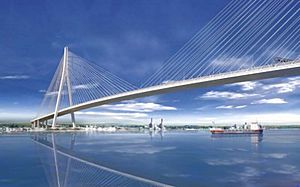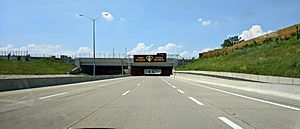Gordie Howe International Bridge facts for kids

Rendering by Windsor–Detroit Bridge Authority
|
|
| Location | Detroit River between Detroit and Windsor |
|---|---|
| Proposer | Michigan Department of Transportation and Ministry of Transportation of Ontario |
| Status | Under construction |
| Type | Bridge |
| Cost estimate | US$4.5 billion |
| Start date | 2018 |
| Completion date | 2024 |
| Supporters | Former PM Stephen Harper (Canada), Former Gov. Rick Snyder (Michigan), Ford Motors' executive chairman Bill Ford, Steve Buehrer (Ohio) |
| Opponents | Manuel Moroun (Detroit International Bridge Company, Canadian Transit Company) |
The Gordie Howe International Bridge (French: Pont International Gordie-Howe) is a huge cable-stayed bridge being built across the Detroit River. It will connect Detroit in Michigan, United States, with Windsor in Ontario, Canada.
This bridge will link major highways: Interstate 75 and Interstate 96 in Michigan will connect to Highway 401 in Ontario. This means cars and trucks can travel easily without stopping, unlike the nearby Ambassador Bridge which leads to city streets in Canada.
The bridge is named after Gordie Howe, a famous Canadian ice hockey player. He played most of his career for the Detroit Red Wings in the National Hockey League.
The idea for this bridge started in 2004. However, the owner of the Ambassador Bridge, Manuel Moroun, was against it. He worried that a new public bridge would reduce his business. In 2012, a Canadian company called the Windsor–Detroit Bridge Authority was created to manage the bridge's building and operation. The U.S. government approved the project in April 2013. Canada then set aside money to buy land in Detroit for the bridge.
Getting the land ready on both sides of the river cost over $350 million. In May 2018, a court ruled against Moroun's efforts to stop the land purchases in Michigan. A group called "Bridging North America" was chosen to build the bridge in July 2018. Construction began soon after, and the bridge is expected to be finished in 2024.
Contents
Building the Gordie Howe Bridge

The project was first called the Detroit River International Crossing (DRIC) in 2004. It got approvals in 2007 and 2008. Ontario started building the Windsor–Essex Parkway, which is a highway that connects to the bridge, in 2011. This highway was later renamed the Rt. Hon. Herb Gray Parkway and was finished in November 2015.
In 2011, it was thought the bridge would be ready by 2016. It was also estimated that the bridge would make $70.4 million in tolls in its first year. In 2012, Canada agreed to pay for the bridge's construction, buy land in Michigan, and build the highway connections. Canada will get its money back from tolls collected on the Canadian side. There will be no tolls on the U.S. side.
On April 12, 2013, the U.S. Department of State gave Michigan the permit needed to build the bridge. This allowed construction to move forward.
Canada set aside $25 million in May 2013 to buy land in Detroit. A group called the Windsor-Detroit Bridge Authority (WDBA) was formed in July 2014 to oversee the project. In February 2015, Canada announced it would also pay for a customs area on the U.S. side of the bridge in Detroit. This area will help people and goods cross the border. The cost of this customs area will also be repaid through tolls.
The cost of building the bridge went up in 2015–2016 because the Canadian dollar's value changed. In January 2016, it was reported that costs could reach $4.8 billion.
Some properties needed for the bridge were still owned by people in July 2016. About 30 out of 900 properties were difficult to get if owners did not want to sell.
In February 2017, U.S. President Donald Trump and Canadian Prime Minister Justin Trudeau both said they supported finishing the project quickly. Construction started in 2018 after a builder was chosen.
In June 2017, the City of Detroit sold land and streets in the Delray neighborhood for the U.S. Customs facility. A $33 million fund was set up to improve the neighborhood. People living there could choose to have their homes fixed or move to a new home in a different area.
On July 5, 2018, the "Bridging North America" group was chosen to build the bridge. This group includes companies like AECOM, Dragados Canada, Fluor Corporation, and Aecon. On September 28, 2018, it was announced the project would cost about $3.8 billion and be finished by the end of 2024.
Bridge Design and Features
The bridge was designed by Erik Behrens. It will have two "A"-shaped towers built on the riverbanks. The bridge will have six lanes for cars and trucks, plus a path for bikes and walkers. It will be about 2.5 kilometers (1.5 miles) long. Its main span, the part between the two towers, will be 853 meters (2,799 feet) long. This will make it the longest main span of any cable-stayed bridge in North America.
The number of vehicles crossing the border is expected to grow a lot. The Gordie Howe International Bridge will help people and goods move smoothly between Canada and the U.S.
The bridge will connect to an extension of Highway 401 in Canada, called the Rt. Hon. Herb Gray Parkway. This parkway is built below ground and has six lanes. It was completed in November 2015.
During the building of the Rt. Hon. Herb Gray Parkway, there were concerns about protecting certain snakes. Biologists moved Butler's garter snakes and eastern fox snakes to new, safe homes. Special fences were built to protect their new habitats.
Why the Bridge Was Needed
In 2010, the Michigan Senate had not yet approved laws for the bridge. Some lawmakers wanted to see money forecasts first. However, the Michigan House of Representatives had already passed the measure. The state of Ohio supported the bridge because Canada is its biggest trade partner.
Michigan Governor Rick Snyder supported the new bridge in 2011. His plan involved using Canadian money to get more funding from the U.S. government.
In October 2011, the Michigan Senate rejected a bill that would have allowed the state to accept $550 million from Canada for the bridge. This caused some tension between the U.S. and Canada.
Challenges and Opposition
The biggest challenge to the new bridge came from Manuel Moroun, who owned the Ambassador Bridge. He sued the governments of Canada and Michigan to stop the new bridge. He also suggested building a second bridge next to his Ambassador Bridge, which he would own. Critics believed Moroun was worried about losing money from his bridge if a new one was built.
In 2012, Moroun spent over $30 million to promote a change to Michigan's constitution. This change would have required voters in Detroit and Michigan to approve the bridge. However, more than 60 percent of voters rejected his idea, allowing the bridge project to continue.
In June 2011, a group called Americans for Prosperity put fake eviction notices on homes in Detroit. These notices told homeowners their properties might be taken for the new bridge. The group said they wanted residents to contact lawmakers and ask them to vote against the bridge.
The company that owns the Canadian side of the Ambassador Bridge also ran ads against the new bridge. They called it a "$2.2 billion road to nowhere." These ads were later found to be linked to Moroun's company in Michigan.
Naming the Bridge
Michigan Governor Rick Snyder didn't like the early names for the bridge, like Detroit River International Crossing (DRIC). He felt "DRIC" sounded too much like the Detroit International Bridge Company (DIBC), which was against the project. The project was then called the New International Trade Crossing (NITC) for a while.
In late 2010, David Bradley suggested naming the bridge after Canadian hockey player Gordie Howe. Howe played most of his career for the Detroit Red Wings. Many Canadian politicians and Howe's son, Marty, supported this idea. They felt the name would show how Howe came from Canada to play in Detroit.
On May 14, 2015, it was officially announced that the bridge would be called the Gordie Howe International Bridge. Stephen Harper, who was Canada's Prime Minister at the time, attended the event. Gordie Howe, who was 87 and unwell, could not be there. When his son asked him what he thought about the name, Howe said, "That sounds pretty good to me." Gordie Howe passed away a year later, on June 10, 2016.
Images for kids


